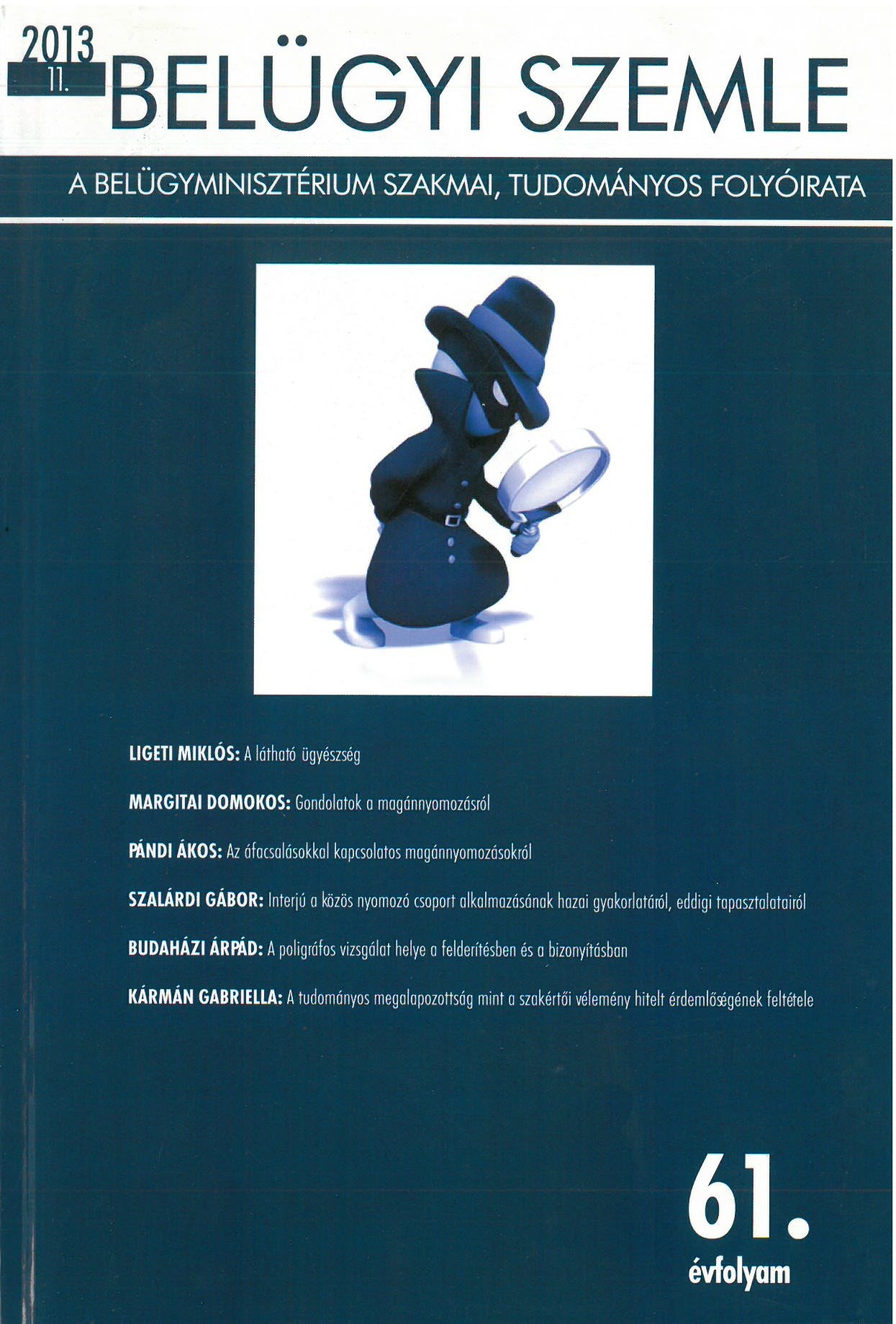Keywords
polygraph examination
evidence
detection
evidence
detection
How to Cite
Using polygraph technology in investigations and evidence finding. (2013). Academic Journal of Internal Affairs, 61(11), 90-111. https://doi.org/10.38146/bsz-ajia.11.v61.i2013.pp90-111
Abstract
Focusing on testimony- examination, and polygraph technology in particular, the author provides an overview of the rules and procedures of investigation and evidence-finding.
References
.

This work is licensed under a Creative Commons Attribution-NonCommercial-NoDerivatives 4.0 International License.
Copyright (c) 2024 Academic Journal of Internal Affairs
Downloads
Download data is not yet available.
Similar Articles
- Gábor Kovács, Péter Gergely, Sándor Kosztya , Zsolt Kozma, Gábor Simon , György Szabados, Réka Anita Tóth, Klára Törő , Roland Weiczner , Recommendation. Key aspects of medical expert’s opinion (report) on the crime of driving under the influence of drugs (DRUID) , Academic Journal of Internal Affairs: Vol. 71 No. 7 (2023)
- Balázs László, Detection and examination in a forgotten bill of Criminal Code , Academic Journal of Internal Affairs: Vol. 69 No. 7 (2021)
- Dávid Petrétei, Theoretical Issues of the Trace and Pattern Evidences in the 21th Century , Academic Journal of Internal Affairs: Vol. 70 No. 5 (2022)
- Mihály Tóth, Comments on the preceding and recent stages of „time travelling” through the legislation of investigation , Academic Journal of Internal Affairs: Vol. 72 No. 10 (2024)
- Anett Fedor, Dilemmas concerning the use of polygraph-technology in the judicial process , Academic Journal of Internal Affairs: Vol. 61 No. 10 (2013)
- László Fázsi, Magdolna Fekete, Reverence issues in criminal law , Academic Journal of Internal Affairs: Vol. 70 No. 5 (2022)
- Éva Kovács-Széles, István Almási, Ákos Balaskó, Csaba Bíró, Károly Bodor, Csilla Csöme, Izabella Kakuja, Zsuzsanna Kreitz, Kornél Papp, Csaba Tóbi, József Volarics, How to respond a crime scene contaminated with radioactive material? , Academic Journal of Internal Affairs: Vol. 68 No. 3. ksz. (2020): Special Issue
- Éva Kovács-Széles, István Almási, Ákos Balaskó, Csaba Bíró, Károly Bodor, Csilla Csöme, Izabella Kakuja, Zsuzsanna Kreitz, Kornél Papp, Csaba Tóbi, József Volarics, How to respond to a crime scene contaminated with radioactive material? , Academic Journal of Internal Affairs: Vol. 68 No. 12 (2020)
- Gergely Gárdonyi, Zoltán Hautzinger, The possible areas for improvement in researches in criminalistics , Academic Journal of Internal Affairs: Vol. 69 No. 10 (2021)
- Tünde Vilics, Interview of the forensic expert and investigation of the experiential content , Academic Journal of Internal Affairs: Vol. 67 No. 11 (2019)
You may also start an advanced similarity search for this article.
Most read articles by the same author(s)
- Árpád Budaházi, Limitations of Brain-based Lie Detection , Academic Journal of Internal Affairs: Vol. 70 No. 1. ksz. (2022): Special Issue
- György Roland Szaktor, András Turi, Árpád Budaházi, Reflections on Plea Bargaining in Criminal Cases , Academic Journal of Internal Affairs: Vol. 70 No. 6 (2022)
